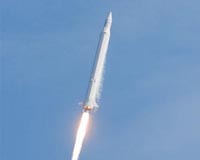 |
Bremen, Germany (SPX) Jun 24, 2010 Astrium, Europe's leading space company, has been awarded a contract by the European Space Agency (ESA) to develop key technologies for new re-ignitable upper stages for new launchers. Under the two-year contract, worth euros 20 million, Astrium will develop advanced technologies that will play a major role in enabling the engines of the cryogenic upper stages (fuelled by liquid hydrogen and oxygen) to be re-ignited. The project is called CUST (Cryogenic Upper Stage Technologies) and is issued under the framework of the Future Launchers Preparatory Programme (FLPP) of ESA. The work will focus particularly on fuel management in the state of zero-gravity and on the thermal insulation of the fuel tanks filled with cryogenic fuel. "It will be a huge challenge to develop the technologies needed to supply fuel to the engine after a period of weightlessness, but they are a vital necessity if we want to make more powerful and flexible launch vehicles. A re-ignitable engine is also an essential requirement for certain types of space missions like placing satellites more effectively in their orbits or trajectories towards 'exotic' destinations, like a Lagrangian point or a planet," said Thomas Renk, head of the CUST project at Astrium. "Our experts in Astrium have the necessary know-how, based on many years of experience with the whole family of Ariane 5 upper stages, and this new contract will enable them to preserve and extend this know-how for future applications." One of the main challenges of designing a re-ignitable cryogenic upper stage, powered by liquid hydrogen and oxygen fuel and operating in a zero-gravity environment, is that of maintaining the fuel in a liquid state. Above a certain temperature, the liquid turns to gas and there is a risk that the fuel will evaporate. Another major challenge is that of directing the fuel to the place where it is needed, namely the feed lines to the engine. To remain in its liquid state, oxygen has to be cooled to below minus 183 degrees Celsius, while hydrogen requires the even lower temperature of minus 253 degrees Celsius. The widely fluctuating "outside" temperatures in space, due to variations in the intensity of the impinging solar radiation, make it very difficult to keep these highly volatile substances in their liquid state over an extended period of time. Innovative insulation concepts are therefore being developed for the fuel tanks and the upper stage itself, to minimise unwanted heat transfer to the fuel. Another challenge to be solved relates to the zero-gravity environment in which the rocket stage resides after the engine has been switched off, causing the liquid fuel to float at random inside the tank. Specific technologies need to be developed to ensure that the fuel will be immediately available at the feed line to the engine when the engine is re-ignited. To support this work, two experiments relating to cryogenic fuel management will be launched in 2011 onboard the Texus sounding rocket, as part of the Texus/Maxus programme that Astrium in cooperation with German Aerospace Center (DLR) has been operating from Kiruna in northern Sweden for over 30 years. Astrium is the prime industrial contractor for Ariane 5, and the company's considerable expertise in the design and construction of the launch vehicle's upper stage was a determining factor in ESA's choice.
Share This Article With Planet Earth
Related Links Astrium Rocket Science News at Space-Travel.Com
 S.Korea, Russia probe rocket failure
S.Korea, Russia probe rocket failureSeoul (AFP) June 11, 2010 South Korean and Russian experts launched an investigation Friday after the fiery failure of the Asian country's latest rocket launch, which some researchers blamed on inadequate testing. The Naro-1 rocket, which was Russian-made but assembled in South Korea, veered off course and exploded 137 seconds after blast-off on Thursday. The mishap came after a first rocket failure last year, th ... read more |
|
| The content herein, unless otherwise known to be public domain, are Copyright 1995-2010 - SpaceDaily. AFP and UPI Wire Stories are copyright Agence France-Presse and United Press International. ESA Portal Reports are copyright European Space Agency. All NASA sourced material is public domain. Additional copyrights may apply in whole or part to other bona fide parties. Advertising does not imply endorsement,agreement or approval of any opinions, statements or information provided by SpaceDaily on any Web page published or hosted by SpaceDaily. Privacy Statement |